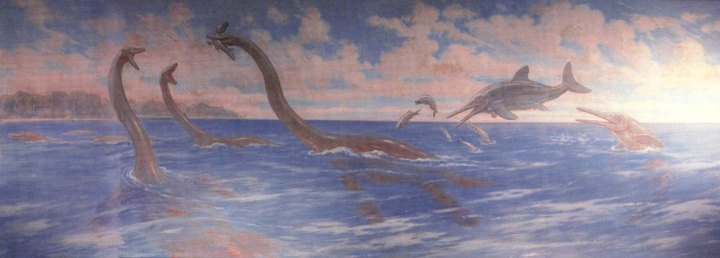
March 11, 2014

Vertebrate paleontologist Darren Naish has posted a wonderful article on the probable behavior and lifestyles of plesiosaurs at his Scientific American blog, Tetrapod Zoology. This is obviously of interest to those in cryptozoology with questions regarding what we know about real plesiosaurs versus speculation about “long necked sea monsters”. Dr. Naish himself does not endorse the “relict plesiosaur” theory but is open minded to the giant long necked seal idea.
Plesiosaurs (this includes the short neck ones generally referred to as pliosaurs) were unique animals, combining features of sea turtles, sea lions and penguins but different from all three. Many questions remain regarding their thermal and respiratory physiology, locomotor morphology, feeding methods and social lives. If you have questions regarding what is currently known about the real plesiosaurs of the Mesozoic ( as opposed to their hypothetical modern day descendants), this article is a very good place to start.
His article begins…
Between the later part of the Triassic and the very end of the Cretaceous, the seas of the world (and some of its rivers, lakes and estuaries as well) were inhabited by the remarkable group of swimming reptiles known as the plesiosaurs. All plesiosaurs – so far as we know – were predators, the shapes of their teeth and jaws indicating that they preyed variously on swimming and benthic invertebrates, on fish, and also on other aquatic reptiles. Some were macropredators that attacked and ate other plesiosaurs as well as ichthyosaurs, swimming crocodyliforms and turtles. Members of several lineages famously possessed long or ridiculously long necks, the flexibility and function of which have long been the subject of debate. Others (referred to as pliosaurs) had long, superficially crocodile-like skulls, and usually combined these with relatively short necks.
Thick-boned, robust ribs and gastralia (here in the Jurassic pliosaur Pachycostasaurus dawni) were probably used as ‘bone ballast’ in these animals. Image by Darren Naish.
In overall body form, all plesiosaurs were generally alike. Their skeletons possess large, plate-like limb girdles mostly positioned on the ventral surface of the body, and there are two pairs of slender, wing-like paddles and a relatively short tail. An interlocking basket of heavy-boned belly ribs (or gastralia) fill in the space between the pectoral and pelvic girdles and presumably helped keep the body stiff during life. There’s no question that plesiosaurs were limb-propelled swimmers. The question is: what sort of limb-propelled swimming did they use? Were they ‘rowers’, ‘fliers’, some combination of the two, and did they use their forelimbs and hindlimbs synchronously, asynchronously, or what? These issues have been much discussed in the literature (Robinson 1975, Tarsitano & Riess 1982, Halstead 1989, Riess & Frey 1991, O’Keefe 2001a, Carpenter et al. 2010) and are the subject of current investigation.

What about the biology, behaviour and lifestyles of these amazing animals? Invaluable studies of jaw biomechanics, tooth form and stomach contents give us insights into what and how plesiosaurs ate, and on how they collected and processed their food (Massare 1987, Taylor 1987, 1992), and some extremely interesting ideas on breathing and olfactory behaviour have been proposed (Cruickshank et al. 1991, Buchy et al. 2006). Trough-like feeding traces preserved on an ancient sea floor provide possible data on plesiosaur foraging behaviour (Geister 1998), and the amazing discovery of a proportionally enormous baby preserved within the body of its mother has given us substantial food for thought as goes the reproductive biology and social lives of these animals (O’Keefe & Chiappe 2011).
In general, however, we of course know very little about plesiosaur biology and behaviour, and I’d say that most questions we might ask can only be informed by inference: by extrapolating or guessing based on what we see in living reptiles and other animals. Remember that, when it comes to interesting questions about the behaviour of long-extinct animals (especially weird ones without precise modern analogues), we’re always constrained by a frustrating lack of information.
Nevertheless, a long interest in both plesiosaurs and the amazing behaviour of extant marine tetrapods means that I’ve long had thoughts about diving behaviour, feeding ecology, social behaviour, intentional beaching and so on in plesiosaurs – I even have a half-finished manuscript done on this subject. So it was fitting that, back in October 2012, Daniel Loxton contacted me to ask if I’d like to be the technical consultant on his new book, Plesiosaur Peril. As with his previous works in the same series – Ankylosaur Attack (Loxton 2011) and Pterosaur Trouble (Loxton 2013) – Plesiosaur Peril is a fantastically illustrated children’s book that uses the fictional story of an individual animal to paint a picture of the lifestyles of ancient animals, using scientific data where possible.
The news is that Plesiosaur Peril is now out, so go buy it!
About Scott Mardis
Scott Mardis has been an active field investigator of the Lake Champlain “Monster” since 1992. He is a former sustaining member of the defunct International Society of Cryptozoology and a former volunteer worker in the Vertebrate Paleontology Dept. of the Philadelphia Academy of Natural Sciences (1990-1992). He co-authored a scientific abstract about the Lake Champlain hydrophone sounds for the Acoustical Society of America in 2010. He currently lives in Bradenton, Florida.
Filed under Bigfoot Report, Cadborosaurus, Cryptozoologists, Cryptozoology, Evidence, Extinct, Eyewitness Accounts, Giant Cryptid Reptiles, Lake Monsters, Living Fossils, Loch Ness Monster, Pop Culture, River Monsters, Sea Monsters, Sea Serpents, Videos